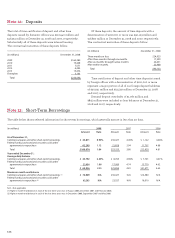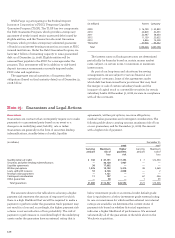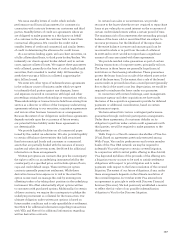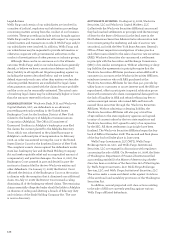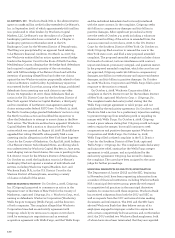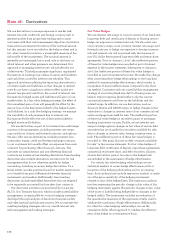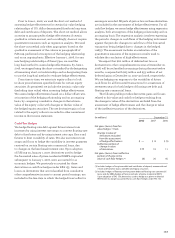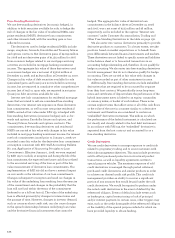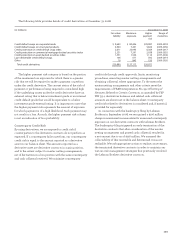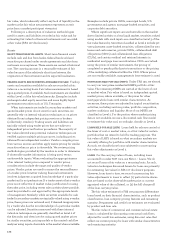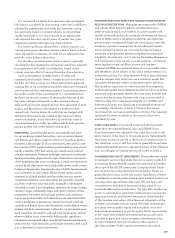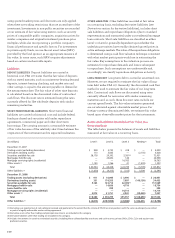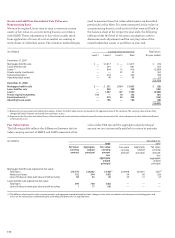Wells Fargo 2008 Annual Report Download - page 134
Download and view the complete annual report
Please find page 134 of the 2008 Wells Fargo annual report below. You can navigate through the pages in the report by either clicking on the pages listed below, or by using the keyword search tool below to find specific information within the annual report.
We use derivatives to manage exposure to market risk,
interest rate risk, credit risk and foreign currency risk, to
generate profits from proprietary trading and to assist
customers with their risk management objectives. Derivative
transactions are measured in terms of the notional amount,
but this amount is not recorded on the balance sheet and is
not, when viewed in isolation, a meaningful measure of the
risk profile of the instruments. The notional amount is
generally not exchanged, but is used only as the basis on
which interest and other payments are determined. Our
approach to managing interest rate risk includes the use
of derivatives. This helps minimize significant, unplanned
fluctuations in earnings, fair values of assets and liabilities,
and cash flows caused by interest rate volatility. This
approach involves modifying the repricing characteristics
of certain assets and liabilities so that changes in interest
rates do not have a significant adverse effect on the net
interest margin and cash flows. As a result of interest rate
fluctuations, hedged assets and liabilities will gain or lose
market value. In a fair value hedging strategy, the effect of
this unrealized gain or loss will generally be offset by the
gain or loss on the derivatives linked to the hedged assets
and liabilities. In a cash flow hedging strategy, we manage
the variability of cash payments due to interest rate
fluctuations by the effective use of derivatives linked to
hedged assets and liabilities.
We use derivatives as part of our interest rate and foreign
currency risk management, including interest rate swaps,
caps and floors, futures and forward contracts, and options.
We also offer various derivatives, including interest rate,
commodity, equity, credit and foreign exchange contracts,
to our customers but usually offset our exposure from such
contracts by purchasing other financial contracts. The
customer accommodations and any offsetting financial
contracts are treated as free-standing derivatives. Free-standing
derivatives also include derivatives we enter into for risk
management that do not otherwise qualify for hedge
accounting, including economic hedge derivatives. To a
lesser extent, we take positions based on market expectations
or to benefit from price differentials between financial
instruments and markets. Additionally, free-standing
derivatives include embedded derivatives that are required
to be separately accounted for from their host contracts.
Our derivative activities are monitored by Corporate
ALCO. Our Treasury function, which includes asset/liability
management, is responsible for various hedging strategies
developed through analysis of data from financial models
and other internal and industry sources. We incorporate the
resulting hedging strategies into our overall interest rate
risk management and trading strategies.
Fair Value Hedges
We use interest rate swaps to convert certain of our fixed-rate
long-term debt and certificates of deposit to floating rates to
hedge our exposure to interest rate risk. We also enter into
cross-currency swaps, cross-currency interest rate swaps and
forward contracts to hedge our exposure to foreign currency
risk and interest rate risk associated with the issuance of
non-U.S. dollar denominated long-term debt and repurchase
agreements. Prior to January 1, 2007, the ineffective portion
of these fair value hedges was recorded as part of interest
expense in the income statement. Subsequent to January 1,
2007, the ineffective portion of these fair value hedges is
recorded as part of noninterest income. We made this change
after converting these hedge relationships to the long-haul
method of assessing hedge effectiveness, which results in
recognition of more ineffectiveness compared to the short-
cut method. Consistent with our asset/liability management
strategy of converting fixed-rate debt to floating-rates, we
believe interest expense should reflect only the current
contractual interest cash flows on the liabilities and the
related swaps. In addition, we use derivatives, such as
Treasury futures and LIBOR swaps, to hedge changes in fair
value due to changes in interest rates of our commercial real
estate mortgage loans held for sale. The ineffective portion
of these fair value hedges is recorded as part of mortgage
banking noninterest income. Finally, we use interest rate
swaps to hedge against changes in fair value of certain debt
securities that are classified as securities available for sale,
due to changes in interest rates, foreign currency rates, or
both. The ineffective portion of these fair value hedges is
recorded in “Net gains (losses) on debt securities available
for sale” in the income statement. For fair value hedges of
long-term debt, certificates of deposit, repurchase agreements,
commercial real estate loans, and debt securities, all parts
of each derivative’s gain or loss due to the hedged risk
are included in the assessment of hedge effectiveness.
For certain fair value hedging relationships, we use
statistical analysis to assess hedge effectiveness, both at
inception of the hedging relationship and on an ongoing
basis. Such analysis may include regression analysis or analy-
sis of the price sensitivity of the hedging instrument
relative to that of the hedged item. The regression analysis
involves regressing the periodic change in fair value of the
hedging instrument against the periodic changes in fair value
of the asset or liability being hedged due to changes in the
hedged risk(s). The assessment includes an evaluation of
the quantitative measures of the regression results used to
validate the conclusion of high effectiveness. Additionally,
for other fair value hedging relationships, we use the
cumulative dollar-offset approach to validate the effective-
ness of the hedge on a retrospective basis.
Note 16: Derivatives


